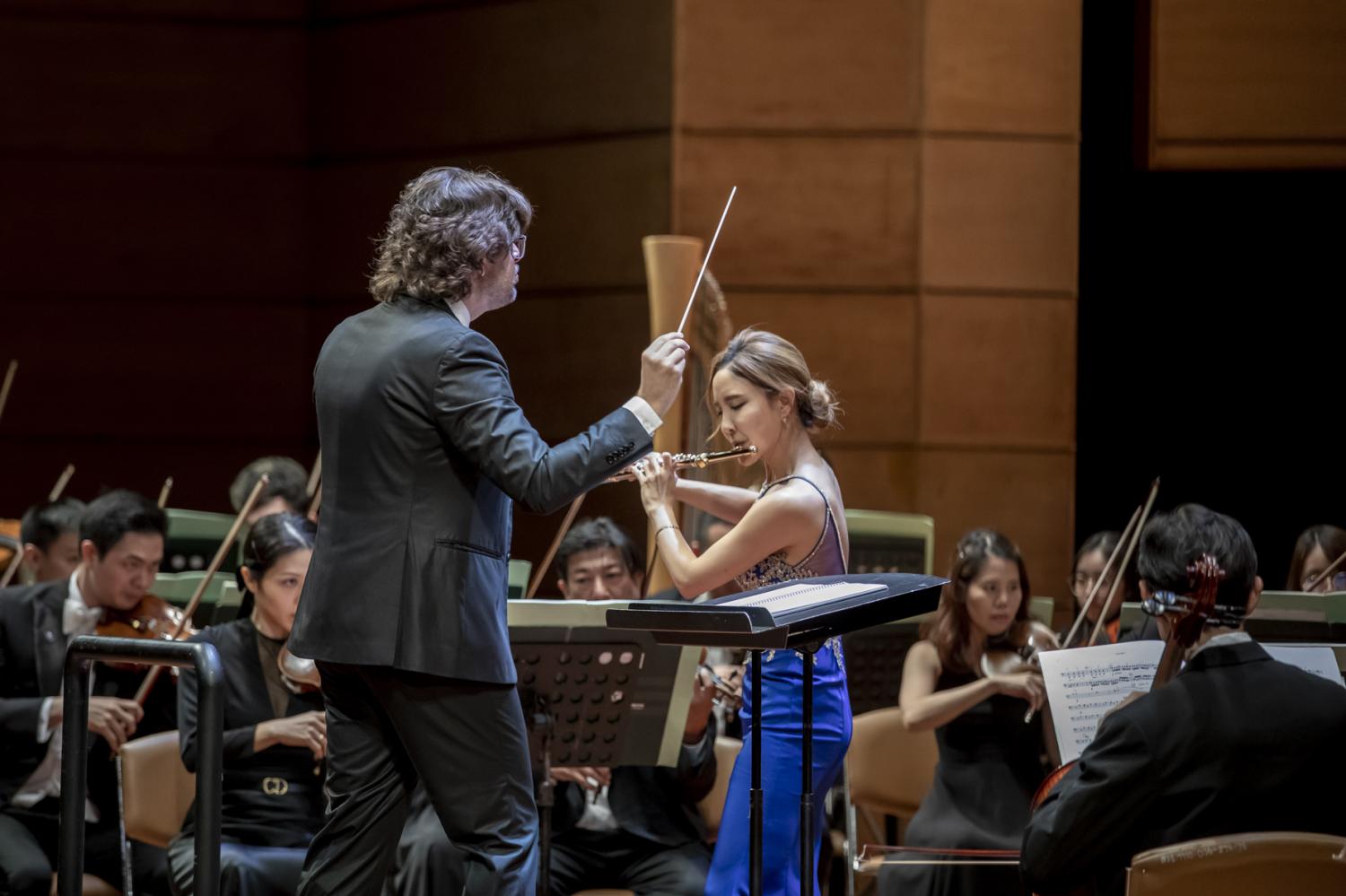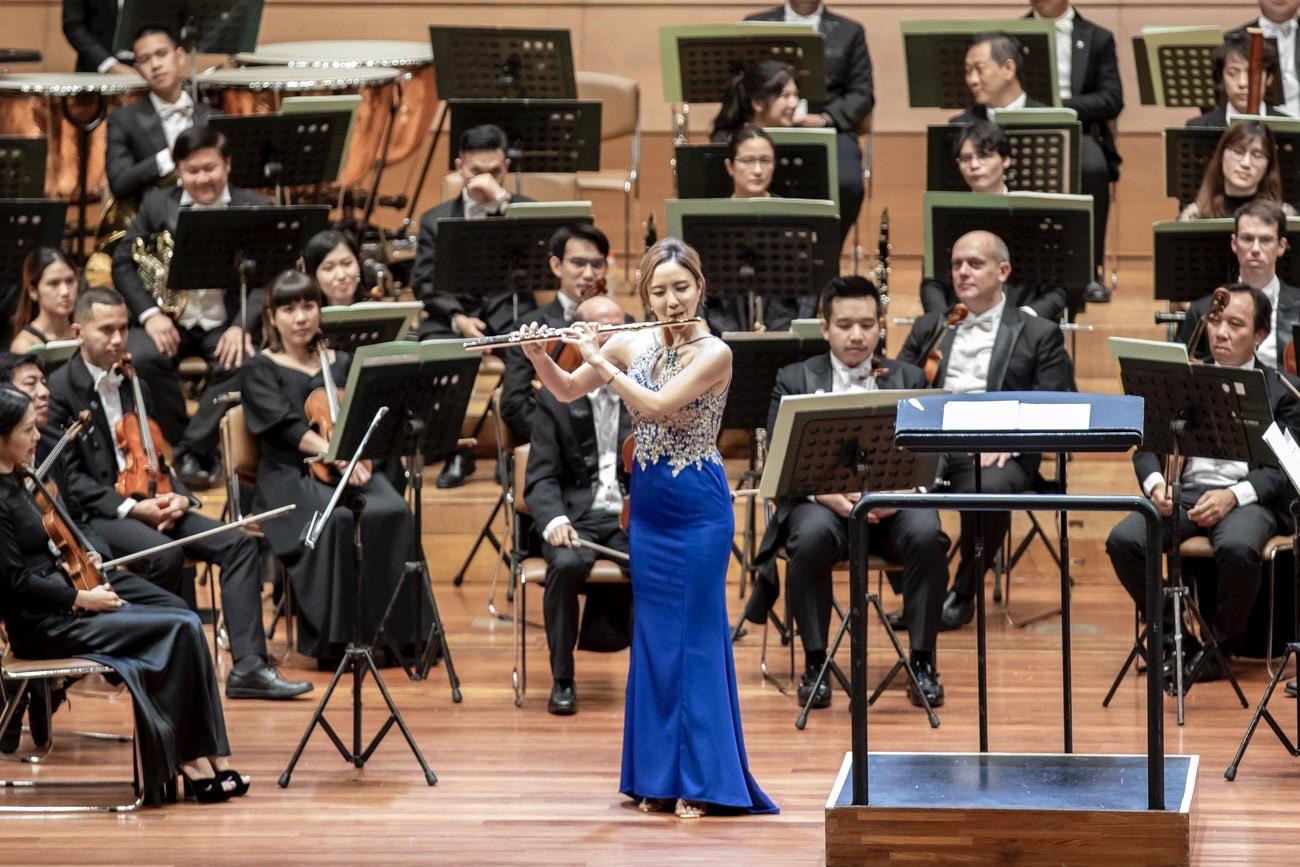To mark the 145th anniversary of B. Grimm Ltd in Thailand, the Royal Bangkok Symphony Orchestra (RBSO) paid suitable homage to its chief supporter and benefactor in mid-September with a concert at the Thailand Cultural Centre (TCC), featuring one of today's bona fide classical superstars, the Korean sensation known as the "Goddess of the Flute" -- Jasmine Choi. Formerly Principal Flute of the Cincinnati Symphony at the tender age of 22, and subsequently the first female player to win the same position with the Vienna Symphony Orchestra, Choi now pursues a successful top-flight solo career which captivates audiences the world over.

Jasmine Choi with her 'golden flute' and conductor Tomas Grau. (Photos: RBSO)
Bangkok audiences have already had the privilege of hearing her on two previous visits. On this occasion, she performed the expansively lush Khachaturian Flute Concerto -- a transcription of the Violin Concerto by legendary French flute supremo Jean-Pierre Rampal. The original work was written for violinist David Oistrakh in 1940. Although her own instrument can boast a few notable concertos of its own, Choi has forged a bold path by significantly increasing the repertoire with entrepreneurial zeal, arranging standard violin concertos such as those of Mendelssohn and Tchaikovsky.
However, the Khachaturian transcription by Rampal dates from 1968, which she has only very recently assimilated into her performance library. A full 45 minutes in length, apart from other considerations such as pure stamina and pyro-technical challenges, this represents a significant feat of memorisation alone.
Impressive Spanish conductor Tomàs Grau was making his debut appearance with the RBSO and opened the concert in quite riotously rousing fashion with George Gershwin's boisterous Cuban Overture, perfect for the celebratory nature of this concert as it evoked a carefree holiday of partying in Havana that the composer enjoyed in 1932. Premiered by the mighty New York Philharmonic at the massive outdoor Lewisohn Stadium to a football-sized crowd of 17,845 people -- with another 5,000 at closed gates reportedly trying to get in -- Gershwin commented: "It was the most exciting night I ever had!"
With the exotic percussion line-up of claves, gourd, maracas, and bongos placed directly in front of the podium -- as stipulated in Gershwin's score -- the essence of this wild excitement was convincingly generated by the RBSO's own rendition inside the TCC, Grau coaxing from the musicians an irresistible Latino spirit of seductively swaying rhythms and jazz-infused harmonies, whilst clarinettist Yos Vaneesorn evoked Rhapsody In Blue in the more lyrical central episode.

RBSO performs under the baton of Tomas Grau from Barcelona.
Included in online Sinfini Magazine's list of the "Top 10 Greatest Flautists in History" in 2015, Choi then took to the stage as her legions of adoring fans gave her an ecstatic reception worthy of an A-list pop star. The Allegro Con Fermezza immediately drew the audience into her charismatic and charming platform presence, with an infectious repeated anapaest rhythm (a rapid short-short-long pattern) which permeates the whole opening movement. Also known as an antidactylus (as in poetic metre), this is the opposite of the more familiar dactyl (long-short-short pattern) and achieved a wonderfully edgy momentum and insistency as Choi worked her way to a huge central cadenza. Grau did well to catch the end of this tour-de-force as he re-introduced the RBSO neatly, the elongated sonata-form continuing its journey in quasi-cinematic fashion. Indeed, aside from close-to-home influences -- most obviously Shostakovich -- one was occasionally reminded of the later film scores of Bernard Herrmann.
Meanwhile, the soothingly languorous Andante Sostenuto featured a stylistically delicious borrowing from Eric Satie's miniature Gymnopodie soundworld, although again extending here to a full fourteen minutes. Choi's fabled "golden tone" was most clearly evident here as seemingly endless melodic voice-leading hypnotised the auditorium. One audience member commented afterwards: "Her flute sounded like the wind blowing through the mountains, or like a clear-eyed deer foraging in the woods" -- aptly poetic words, once again reflecting cinematic imagination.

Jasmine Choi performs Khachaturian's Flute Concerto.
A galloping, frenzied 3/8 rhythm for the entire orchestra then introduced the cheerfully sprightly Rondo theme of the Allegro vivace finale. Choi's virtuosic whirlwind of a display evoked a vigorous, wild country dance as this dazzling performance drew to a jubilant close. However, her encore then managed to surpass even this. The Great Train Race by Ian Clarke featured daredevil extended techniques, such as multi-phonics (chords) and circular breathing, which had the audience practically guffawing in amazement. This was the only occasion that this reviewer has ever witnessed a TCC audience break out into rapturous applause, not just after the encore, but also during it -- truly breathtaking!
Mussorgsky's Pictures At An Exhibition (orchestrated by Ravel) then gave maestro Tomàs Grau the ideal opportunity to fully display and introduce his conducting credentials on this, his first successful collaboration with the RBSO. Chief Conductor and Artistic Director of the Franz Schubert Filharmonia (located in Tarragona near his birthplace of Barcelona), his sense of confident authority on the podium and clear-sighted insight into the aesthetics and structure of this imposing staple of the orchestral canon was apparent throughout.
Each of the connecting Promenade sections was effectively differentiated, reflecting the subtle orchestration development of the noble, striding unifying theme, whilst each of the markedly varied ten musical "portraits" of the gallery Pictures themselves was characterised with abundant attention to detail.
Marvellous playing was delivered by many individual players of the RBSO during this powerful reading of the great score, but special mention must be made of Principal Trumpet Pitipong Pookaew, whose depiction of the Polish character Schmuyle was sheer perfection.

